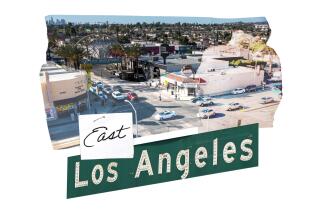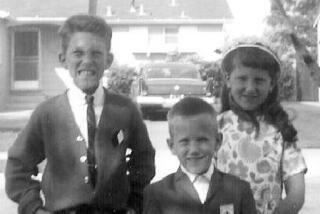Neighborhood Center Reflects Changing Face of Eastmont
The Rev. Douglas Smith, director of the Eastmont Community Center, was surprised when he began to hear complaints about the center’s lunchtime prayer.
“They were praying to the Virgin of Guadalupe and some of the Central Americans didn’t like that because the Virgin of Guadalupe is from Mexico,” Smith said.
For Smith, the objections were proof of the many changes in Eastmont, a quiet neighborhood of small but attractive homes with fenced-in lawns in East Los Angeles.
After a period of “white flight” followed by Latino activism in the ‘60s and the arrival of middle-class Mexican-American families, new immigrants are now trickling in and promise to bring significant changes to the Eastmont neighborhood.
Shift to Central American
“In 15 to 20 years, this will be a largely Central American community,” said Smith, 41, a minister in the Christian Church (Disciples of Christ).
On the eastern flank of unincorporated East Los Angeles, wedged between Montebello, Monterey Park and the City of Commerce, Eastmont has long been one of the few East Los Angeles neighborhoods to maintain a suburban flavor.
Now, “Eastmont is becoming more like downtown,” Smith said. “The homeowners, mostly Mexican-American, are getting older. They’re already being outnumbered by the people they’re renting to.”
Eastmont homeowners are moving to the more affluent suburbs of Monterey Park and Hacienda Heights and renting out their Eastmont homes, said Frank Villalobos of Barrio Planners, an East Los Angeles-based architectural and urban planning firm. “It’s the evolution of the barrio all over again.”
Villalobos said that although Eastmont still offers “the most decent housing in East Los Angeles,” it may soon resemble other East Los Angeles communities such as Boyle Heights, where 75% of homes are owned by absentee landlords.
Rentals Increased
According to the U.S. Census, the number of renters in the neighborhood increased throughout the 1970s and ‘80s. Renters now make up 54% of Eastmont’s population and earn about 40% less than the neighborhood’s homeowners.
Most Eastmont homes were built shortly after World War II, when returning veterans moved into the area east of Atlantic Boulevard.
Latino families began to arrive in the late ‘50s and early ‘60s, after “deeds of trust” that prohibited homeowners from selling their property to Latinos and blacks were overturned by a series of U.S. Supreme Court decisions, Villalobos said.
Mexican-American homeowners quickly displaced the neighborhood’s Anglo residents, and in 1968 the 15 remaining parishioners of the Eastmont Christian Church--once a 200-member Protestant congregation--decided to transform their church into a community center serving the mostly Mexican-American community.
Today, the church’s pews are gone, replaced by classrooms and offices, where Latino immigrants learn English and find help filling out tax forms. Children paint and draw where church members were once married and baptized.
Smith said the neighborhood’s newer residents, mostly Central American and Mexican immigrants, identify the neighborhood as a part of East Los Angeles--not as “Eastmont,” a term that dates from an earlier period in the community’s history.
Victor Ortiz, a 50-year-old Salvadoran immigrant, moved to the neighborhood six years ago and now works part-time as the community center’s weekend janitor.
Ortiz said his new home is a big improvement over his former Third Street apartment near downtown. “On Third Street, there’s a lot of deterioration, a lot of vandalism and it isn’t safe for children,” he said in Spanish.
In Eastmont, he said, his 6-year-old son has a yard to play in and “everyone belongs to the Neighborhood Watch program.”
School District Statistics
Ortiz sends his son to Eastmont Elementary School, where 55% of the school’s students are native Spanish speakers who speak little English--most of them recent immigrants. At nearby Eastmont Intermediate School in Montebello, the number of students who speak only Spanish has increased 48% since 1981, according to statistics provided by the Montebello Unified School District.
Linda Ortiz, the community center’s director of social services, said she has noticed other subtle but important changes in the neighborhood, including the appearance of homeless families. Each day she helps about 10 people find employment, emergency food and temporary shelter.
The center keeps a well-stocked pantry with basic staples such as bread and flour, as well as other, tastier items, such as canned jalapeno peppers. The thrift store is made up of two small rooms in the back of the building with eight racks of used clothes, where “the children’s clothes are the hot item,” Smith said.
Many Eastmont residents rely on the center because they live in an unincorporated area of Los Angeles County and do not have access to many of the services available to residents of the neighboring communities, Smith said.
Neighborhood Issues
What services they do have came after struggle. Throughout the late ‘60s and early ‘70s, Eastmont residents and community center volunteers pleaded and argued with--and sometimes openly confronted--county authorities over neighborhood issues, Smith and others said.
Neighbors working out of the center in the ‘70s wrote the proposals that established the center’s Headstart child care and education programs, Smith said, and a group of local residents calling itself the Neighborhood Council left a legacy of increased parent participation in the schools.
“We don’t have to ask them (parents) to come to meetings anymore, even the parents from Mexico who have never spoken up before or said anything,” said Isabel Villarreal, who worked at the center as a volunteer in the ‘70s.
Despite the changes in the neighborhood, Smith said, the community center will continue to encourage Eastmont residents to organize for better services. “The daily struggles take so much time and energy that people have lost sight of the fact that their lives can be better if they work together.”
More to Read
Sign up for Essential California
The most important California stories and recommendations in your inbox every morning.
You may occasionally receive promotional content from the Los Angeles Times.











